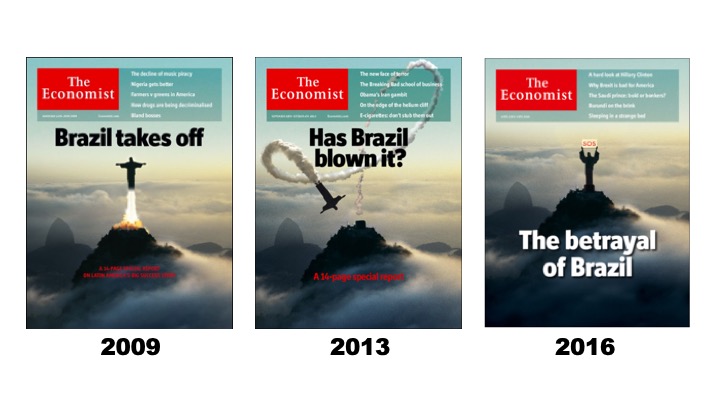In 20 years of studying Latin American politics and economics, I’ve never heard as much pessimism about the future as I do today. In corporate boardrooms, presidential palaces and virtually every WhatsApp group I’m part of, the fear is of a “lost decade” – that the 2020s will be a dark era of rising poverty, social unrest, debt defaults and creeping authoritarianism.
God knows, there’s plenty of reason to worry. As 2020 draws to a close, Latin America is, sadly, ground zero for the global pandemic, with six of the world’s 10 deadliest outbreaks (Peru, Bolivia, Brazil, Ecuador, Chile and Mexico) so far as measured by confirmed deaths per capita in a Johns Hopkins database. The real numbers are surely higher.
Source: Johns Hopkins University of Medicine, current as of Oct. 13, 2020
Note: Excludes Andorra and San Marino
Meanwhile, the region’s economies are expected to shrink more than 8% on average. That would be twice as bad as the United States, and worse than any other region in the world except the Euro Area, according to the International Monetary Fund.
Source: IMF, Oct. 2020
There’s no doubt that COVID-19 has exposed many of Latin America’s most glaring problems, from high inequality to uneven access to healthcare and low trust in government, all of which made the fallout worse. The region was already struggling badly prior to the pandemic, with street protests from Chile to Colombia, the world’s worst violence (33% of global homicides, despite having just 8% of its population) and some of its worst-performing economies.
But I also believe that at least some of the pessimism about the region’s prospects is exaggerated. I think it ignores Latin America’s recent history, and also commits a fundamental error – a human error. I believe the coming decade will be a difficult one for the region, one full of challenges; but perhaps not the apocalypse many currently expect.
In this article, which is based on a presentation I’ve been giving to various audiences (remotely, of course) in recent months, I will try to articulate – based on data, conversations with experts, and my own experiences – why I think that’s the case.
We’ve been here before
To explain, I’d like to tell you just a bit of my personal story.
In early 2000, just after graduating from the University of Texas, I bought a one-way ticket to Buenos Aires with the dream of becoming a foreign correspondent. After some initial struggles, I found work as a reporter with the Reuters news agency. By a stroke of fate, my first job was to cover one of the world’s worst economic meltdowns of the last half-century.

Argentina’s crisis of 2001-02 was in many ways worse than the current mess. It cost the country 20% of its gross domestic product, and at its peak one in three Argentines were unemployed. The infamous “corralito” froze and then devalued people’s bank accounts (costing me about $3,000, a veritable fortune for a 23-year-old reporter). For most Argentines, the consequences were infinitely worse. Widespread hunger triggered riots and looting which in turn forced President Fernando de la Rúa to resign and leave the Casa Rosada by helicopter (image below). Argentina would see five different presidents in a period of just two weeks.

The early 2000s were very difficult times – not just in Argentina, but all over Latin America. In Colombia, the government nearly ran out of cash to pay workers and the FARC was at its peak, staging record kidnappings and bombings in the months prior to Alvaro Uribe’s election. Brazil was enduring a terrible financial crisis as investors panicked about what Luiz Inácio Lula da Silva would do if elected president. A failed coup and general strike in Venezuela plunged that country deeper into polarization and the exodus of its middle class. Mexico was realizing that neither NAFTA nor the departure of the Institutional Revolutionary Party (PRI) after 71 years in power would be enough to trigger a new era of faster growth.
Indeed, as late as 2002, many people were convinced the 2000s would be a lost decade for Latin America.
What followed instead – to the surprise of virtually everyone – was the best decade in the region’s modern history.
Source: IDB
The chart above is in many ways the centerpiece of this article. It shows the region’s average GDP over the past 50 years on a per capita basis, meaning it’s adjusted for population growth. The chart makes clear the profoundly cyclical nature of Latin America’s economies throughout history. It also shows how uniquely prosperous the period from about 2003 to 2013 really was. Some 50 million Latin Americans rose out of poverty and into the middle class, able to afford cars, airplane travel or washing machines for the first time. Inequality fell too, if just a bit.
Now, I know what many of you are thinking – because we journalists are cynics, too. “Come on, that was only because of China, because of the commodities boom. We won’t see that happen again in our lifetimes.” I think the real story is more complicated – but let me come back to that in a moment.
For now, let’s fast forward to 2010. That was the year I moved to Brazil, also to work as a reporter for Reuters. The mood was euphoric, the polar opposite of what I’d experienced a decade earlier living in Argentina. Brazil’s economy grew 7.6% that year; few believed that was sustainable, but nobody – and I mean nobody – expected it would grow less than 3% in the years ahead. Other countries were experiencing a similarly charmed moment. On Wall Street and inside the region, there was serious talk of the 2010s being the “Latin American decade,” and of living standards converging with nations like Spain and Portugal.
The story of what happened instead can be told through these three covers of The Economist:

These covers were about Brazil, but they could have been about the region as a whole in the 2010s. Some countries suffered more than others; those on the Pacific coast, which tended to be more open to trade, performed better than the likes of Argentina and Brazil, much less Venezuela. But overall, Latin America ended up falling badly behind during an era of robust global growth:
Source: World Bank
So what’s my point here?
Well, I was talking recently with a friend who has worked for 40 years in commercial real estate. He was discussing the cyclical nature of his business, and lamenting how people always seem to forget that. He said, “I feel like I work in an industry of 10-year cycles, and 7-year memories.”
I just about jumped out of my chair, because that also describes Latin America, and my experiences over the past two decades. Every time Latin America is at the top of the curve, people get carried away and invent reasons why the good times will last forever. During crises, the opposite happens, and a kind of fatalism takes over. The list of people I’ve seen fall victim to this way of thinking includes some very smart people: CEOs, big-name economists, Wall Street investors, politicians, and everyday citizens as well. Virtually no one seems immune.
As to why it keeps happening… perhaps you’d need a psychologist to answer that properly.
But it does raise obvious questions: Are we in a similar moment now? Are today’s glum predictions of another “lost decade” the surest sign that things won’t be so bad? Or has Latin America really entered a new kind of downward spiral, meaning the cyclical recovery won’t be coming this time around?
It’s the education
I think we have to strongly consider the possibility the darker scenario is true. Perhaps COVID-19 and the negative trends of the 2010s, plus other factors such as falling birthrates, near-sighted populist politics and chronically low investment, have condemned the region to an unusually difficult period ahead. In my darkest moments, I wonder if the entire Western world is in decline, and Latin America is simply at the vanguard of that.
But then I think of the 2000s, and the real lessons from the last boom.
Much of the growth was due to China and the commodities cycle; but not all of it. The 2000s was also an era when Latin America reaped the benefits of hard-won reforms, many of which had been made in the previous decade. These ranged from steps to reduce inflation and stabilize the financial system (Brazil and Peru, among others) to improvements in security (most notably Colombia) to an enhanced social safety net and welfare programs that helped create a new class of more confident consumers (Argentina, Brazil, Peru and elsewhere). In retrospect, many of these positive trends were visible prior to the boom, hiding in plain sight.
What might the under-appreciated reasons for optimism be this time around? What might lead the 2020s to surprise us on the upside, if just a bit? I will highlight five possibilities here.
The first, and I think most important reason, is 1) improving education levels. The percentage of young people in Latin America who were enrolled in higher (“tertiary”) education more than doubled from 1991 to 2010, and now includes more than 40% of that age group:
Source: World Bank, using United Nations data
No other region of the world has seen anything like this. Twenty years ago, Latin America’s higher education rates were comparable to Central Asia’s; today they have soared ahead. More than 2,300 new institutes of higher education have opened in Latin America since the early 2000s, according to a World Bank report. Those who graduated amid that boom are just now reaching the prime years of their careers, suggesting a dividend that is about to begin paying off.
Source: UNESCO
Yes, there are questions about the uneven quality of the education itself. Yes, the pandemic is forcing many of today’s students to drop out to help support their families. But this new generation may still be the best hope we’ve seen for finally improving productivity in Latin America, which studies suggest has been stagnant for more than 40 years now. If economies are to grow in the 2020s, it will almost have to come from productivity – commodities exports and the expansion of the labor force, the main two growth engines of recent decades, are unlikely to help.
The 2) growth of mobile technology seems destined to favor Latin America, given its high usage rates, with many predicting the region will “leapfrog” stages of development in areas like fintech and mobile banking. A period of 3) sustained low global interest rates will drive investors to seek higher yield in riskier places, meaning an opportunity for Latin America – though there is no guarantee of success.
One of the region’s most glaring weaknesses right now, in my view, is poor leadership at the presidential level. Too many presidents, on both left and right, are focusing on the “culture wars,” catering only to their base, or clinging to old, discredited ideas about the economy. But in many countries, 4) democratic institutions are proving resilient, helping atone for some of those shortcomings. Leaders in Brazil’s Congress, for example, almost single-handedly passed a major pension reform in 2019 – and have served as a safeguard against executive overreach since then. Chile has channeled the popular rage of last year into a referendum process for a new Constitution. Argentina has enjoyed a degree of political consensus about how to handle the pandemic, although that has faded in recent weeks.
The fifth and final reason for relative optimism is related: 5) changing values in the private sector. I know some people roll their eyes at this, but bear with me. Business leaders around Latin America — especially the younger ones — are waking up to the need to lead on certain topics – that they can’t just leave politics to the politicians. Some of this is driven by changing governance standards, as well as the demands of their own customers.
I hear Brazilian business leaders pushing much more aggressively than before for protections for the Amazon, for example. Entrepreneurs across the region are lobbying more vocally for greater trade and integration. There’s also much more emphasis on compliance standards following the big scandals of the 2010s, including Lava Jato. I don’t expect miracles on any of these fronts; corruption has not disappeared. But they should help create a more transparent and ultimately more fair business environment, with fewer of the oligopolies and inside dealing that have stifled growth and entrepreneurship in decades past.
Add these things up, and I think there are at least some reasons for hope.
In conclusion: In 20 years following and writing about Latin America, I’ve seen a lot of crises. But there’s been a lot of progress too. I disagree with much of the fatalism I hear, because I feel like it ignores the region’s recent history, which includes successes that were not solely the result of external forces, but internal decisions that involved sacrifice and hard work.
I believe it’s at least possible that with the right leadership, and the right decisions, Latin America can positively surprise us once again. The 2020s will only be “lost” if we all allow it to happen.








